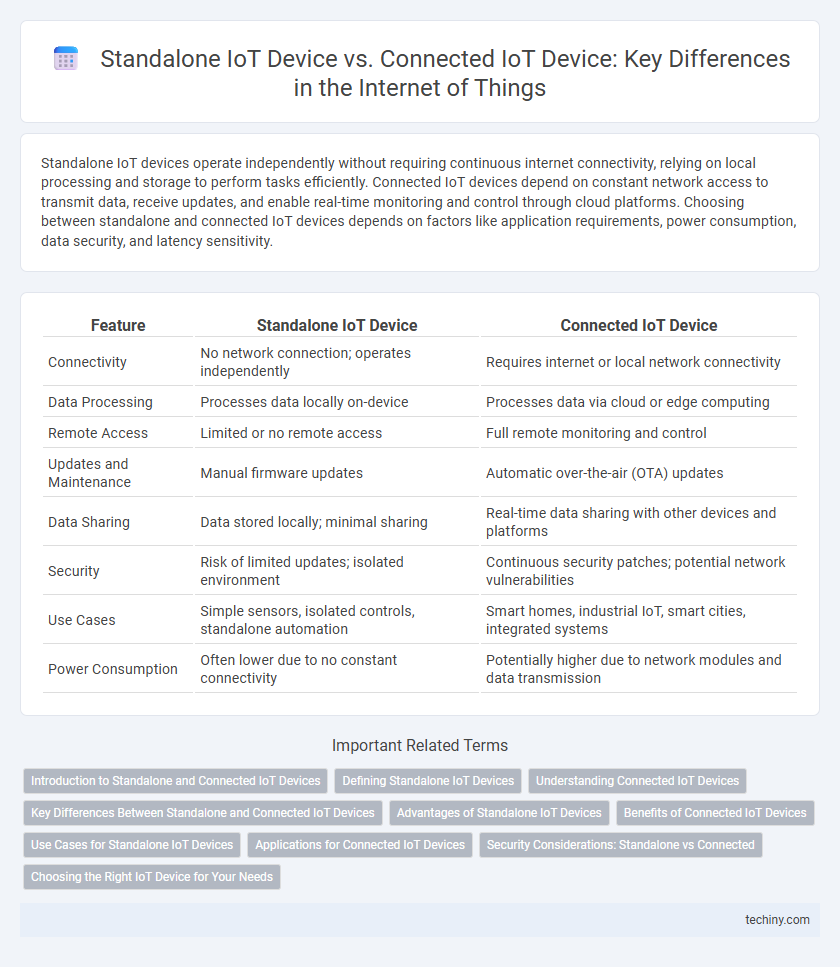Standalone IoT devices operate independently without requiring continuous internet connectivity, relying on local processing and storage to perform tasks efficiently. Connected IoT devices depend on constant network access to transmit data, receive updates, and enable real-time monitoring and control through cloud platforms. Choosing between standalone and connected IoT devices depends on factors like application requirements, power consumption, data security, and latency sensitivity.
Table of Comparison
| Feature | Standalone IoT Device | Connected IoT Device |
|---|---|---|
| Connectivity | No network connection; operates independently | Requires internet or local network connectivity |
| Data Processing | Processes data locally on-device | Processes data via cloud or edge computing |
| Remote Access | Limited or no remote access | Full remote monitoring and control |
| Updates and Maintenance | Manual firmware updates | Automatic over-the-air (OTA) updates |
| Data Sharing | Data stored locally; minimal sharing | Real-time data sharing with other devices and platforms |
| Security | Risk of limited updates; isolated environment | Continuous security patches; potential network vulnerabilities |
| Use Cases | Simple sensors, isolated controls, standalone automation | Smart homes, industrial IoT, smart cities, integrated systems |
| Power Consumption | Often lower due to no constant connectivity | Potentially higher due to network modules and data transmission |
Introduction to Standalone and Connected IoT Devices
Standalone IoT devices operate independently without requiring a constant connection to the internet, performing specific tasks locally using embedded sensors and processors. Connected IoT devices rely on network connectivity to communicate, share data, and integrate with cloud services for real-time monitoring, remote control, and data analytics. Understanding the distinction between standalone and connected IoT devices is essential for designing efficient IoT systems optimized for power consumption, data processing, and communication needs.
Defining Standalone IoT Devices
Standalone IoT devices operate independently without relying on external networks or cloud services, enabling local data processing and decision-making. These devices are designed to function efficiently in isolated environments with limited connectivity, enhancing security and reducing latency. Common examples include smart thermostats and industrial sensors that perform specific tasks autonomously.
Understanding Connected IoT Devices
Connected IoT devices rely on continuous network connectivity to exchange data with cloud platforms, enabling real-time monitoring, remote control, and dynamic updates. These devices leverage protocols like Wi-Fi, Bluetooth, and cellular networks to maintain constant communication, enhancing interoperability and scalability within smart ecosystems. Data collected from connected IoT devices supports advanced analytics, predictive maintenance, and improved decision-making across industries such as healthcare, manufacturing, and smart cities.
Key Differences Between Standalone and Connected IoT Devices
Standalone IoT devices operate independently without constant internet connectivity, relying on local data processing and storage to perform specific tasks, which enhances security and reduces latency. Connected IoT devices, however, transmit data continuously to cloud platforms for real-time analytics, remote monitoring, and centralized control, enabling advanced functionalities and integration with other systems. The key differences lie in their connectivity requirements, data handling methods, and overall network dependency affecting scalability, power consumption, and user interaction.
Advantages of Standalone IoT Devices
Standalone IoT devices offer enhanced security as they operate independently from external networks, reducing vulnerability to cyberattacks. These devices require lower power consumption and maintain functionality even in environments with limited or no internet connectivity. The simplicity of standalone IoT systems results in reduced dependency on cloud infrastructure, leading to faster data processing and improved real-time responsiveness.
Benefits of Connected IoT Devices
Connected IoT devices offer real-time data sharing and remote management capabilities, enhancing operational efficiency and enabling proactive maintenance. They facilitate seamless integration with cloud platforms and analytics tools, driving smarter decision-making and predictive insights. Continuous connectivity also supports scalability and interoperability across diverse IoT ecosystems, maximizing device utility and value.
Use Cases for Standalone IoT Devices
Standalone IoT devices operate independently without relying on constant internet connectivity, making them ideal for use cases such as remote environmental monitoring, industrial equipment maintenance, and secure access control systems. These devices excel in locations with limited or unreliable network infrastructure, ensuring continuous operation and data collection. Examples include smart meters in rural areas, isolated sensors in agriculture, and offline safety alarms in hazardous environments.
Applications for Connected IoT Devices
Connected IoT devices are extensively used in smart homes, enabling real-time monitoring and control of lighting, security systems, and climate to enhance convenience and energy efficiency. In industrial environments, connected IoT sensors facilitate predictive maintenance by continuously collecting and analyzing machine data, reducing downtime and operational costs. Urban infrastructure benefits from connected IoT through smart city applications like intelligent traffic management and environmental monitoring, improving public safety and sustainability.
Security Considerations: Standalone vs Connected
Standalone IoT devices offer enhanced security by operating independently, reducing exposure to network-based cyber threats and minimizing attack surfaces. Connected IoT devices, while enabling real-time data exchange and remote management, introduce vulnerabilities such as man-in-the-middle attacks, unauthorized access, and data interception, requiring robust encryption and network security protocols. Implementing strong authentication methods, regular firmware updates, and secure communication channels are critical to mitigating risks in connected IoT ecosystems.
Choosing the Right IoT Device for Your Needs
Standalone IoT devices operate independently without requiring constant internet connectivity, making them ideal for applications with limited network access or strict data privacy needs. Connected IoT devices rely on continuous internet connections to enable real-time data exchange, remote monitoring, and advanced analytics, offering enhanced functionality for smart homes, industrial automation, and healthcare. Selecting the right IoT device depends on factors such as use case requirements, security considerations, power availability, and the necessity for real-time data interaction.
Standalone IoT device vs Connected IoT device Infographic

 techiny.com
techiny.com